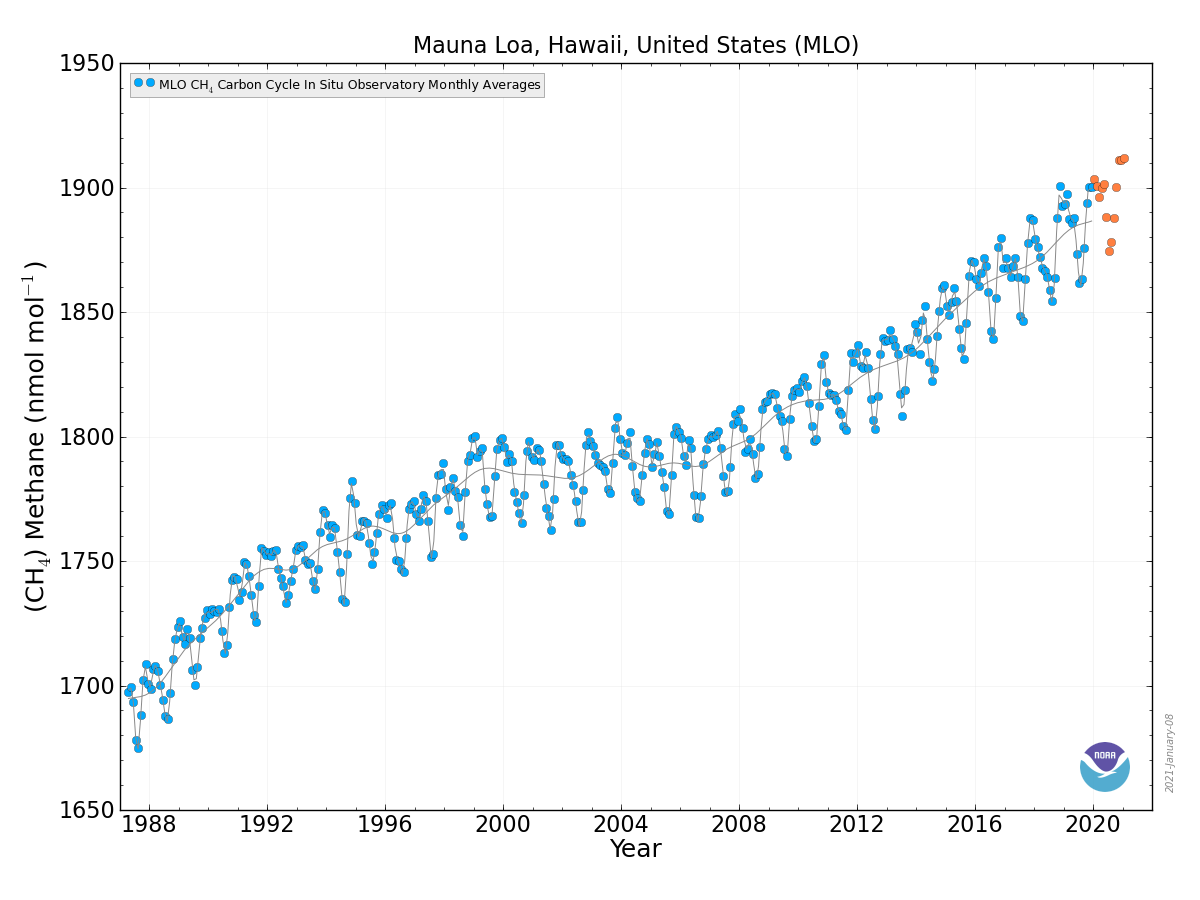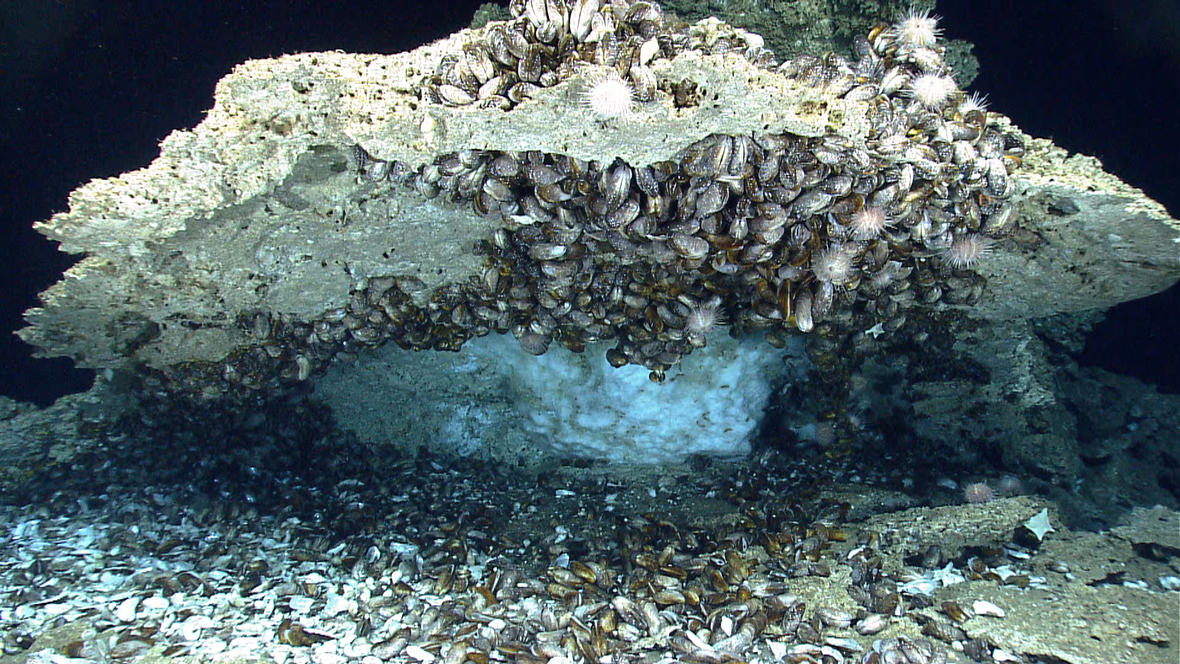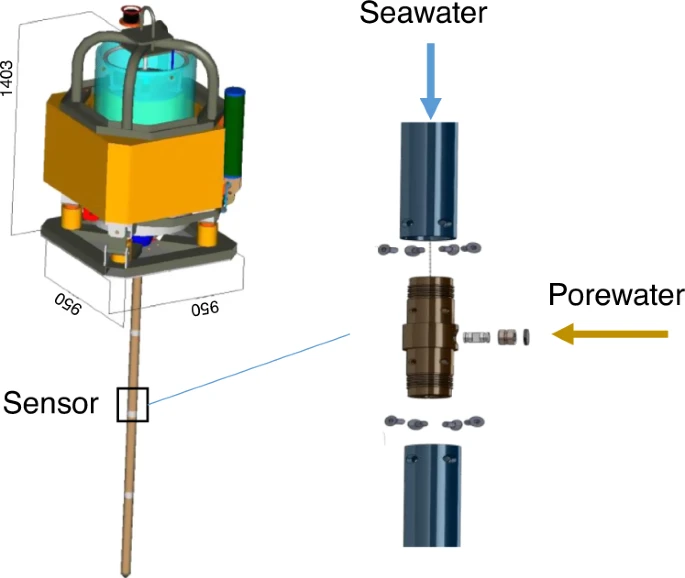Citation: Sultan, N., Plaza-Faverola, A., Vadakkepuliyambatta, S., Buenz, S., & Knies, J. (2020). Impact of tides and sea-level on deep-sea Arctic methane emissions. Nature Communications, 11(5087). https://doi.org/10.1038/s41467-020-18899-3
[hr]
In the last few decades, there has been a dramatic increase in the amount of methane released to the atmosphere (Figure 1). The methane comes from a wide variety of sources – both natural and human-induced – and one is the vast reservoirs of methane hydrate (Figure 2) that are stored below the seafloor. These hydrates are solids composed of methane and water molecules, and – like ice – they’re only stable below certain temperatures and above certain pressures. When the pressure decreases or the temperature increases, the hydrates break down into methane gas, which can escape into the water above, and ultimately, into the atmosphere. Because methane is a very potent greenhouse gas, it’s extremely important that we monitor hydrate reservoirs and understand the mechanisms behind their breakdown.


Hydrates in a Pressure Cooker
Methane hydrates have been dissociating at faster rates recently, and scientists have mainly been focusing on increasing ocean temperature as its cause. They have also wondered whether increases in pressure might be an effective counterbalance. (Climate change is leading to higher ocean temperatures, but it’s also contributing to sea level rise. More water sitting above a methane hydrate will increase the pressure it’s under, and might keep it a stable solid despite slightly higher temperatures.)
However, there are no great ways to test this theory, because sea level rise would be quite difficult to simulate across the entire ocean! A team of scientists from the Arctic University of Norway thought of a work-around, instead. They decided to measure whether tides – where the moon causes natural fluctuations in sea level – can affect methane hydrates at the seafloor (Figure 3).

Testing the Impacts of Tidal Cycles

The scientific team traveled out to the western coast of Svalbard –where there are well-studied hydrate deposits – to investigate. They deployed a device called a piezometer (Figure 4) in two seafloor locations: one 950 meters below the ocean surface, and a second 1330 meters (1.33 kilometers) below the surface. The team was expecting methane hydrates in both locations to be extremely stable, because the pressures were so high and the temperatures so low (around 0ºC).
The team left the piezometers in the sediment for several days before returning to collect them. Pressure and temperature gauges in the piezometers recorded data the entire length of time, and the scientists were able to determine that pressures inside the sediment were not stable. Small gas bubbles were being produced in the sediment at low tide, indicating that even slight changes in the amount of water above can be felt in sediments ~1 kilometer below the surface!
Despite being well within a zone where hydrates should always be stable, the scientists found that methane escape was occurring.
Implications
This unexpected finding means that even tiny pressure changes can release significant quantities of methane from the seafloor. Furthermore, even in deep water – where methane hydrates should be stable – small amounts of methane are being released every tidal cycle. If this is happening in deep waters, what is happening in shallower waters, where hydrates are less stable, and the chances of methane escape to the atmosphere are higher?
The scientists suggest that permanent monitoring devices be installed off Svalbard to answer these questions, and to improve our estimates of methane release from the Arctic Ocean. This study is a great example of why it’s important for ocean scientists to gather data from multiple time points. Small daily events, like tidal cycles and light cycles, can have big impacts on physical and biological processes in the ocean.
Nice work moon – talk about throwing your weight around!
[hr]
I’m a PhD candidate in Earth System Science at Stanford University, and I study how microbes in deep ocean sediments produce and consume greenhouse gases. I’m a native of the landlocked state of Minnesota, so I’ve always been fascinated by the ocean. When I’m not in the lab, I love to race triathlons, forward “The Onion” articles to friends and family, and hike with my hound dog Banjo.


